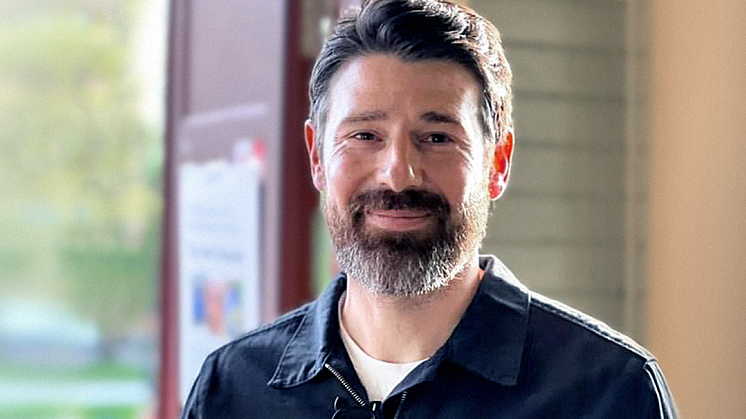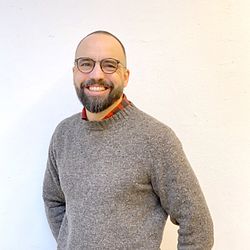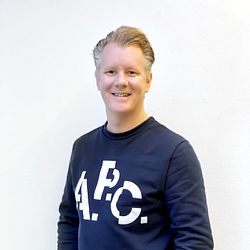
Blogginlägg -
Alster Agile with Tobias Lendel
Name: Tobias Lendel
Job Title: Design Director & Partner
Time at Alster: 14 years
Hobbies: Alpine skiing, Running, and Woodworking
Can you tell us a little about how your design process has changed throughout your career?
Where should I begin? Maybe I can begin back at the beginning of my career. I started in this industry as a designer and art director in advertising, working with web design. The industry was so new then. We were handed print projects and just told to “go do something cool for the web.” The expectations in those early roles were super ineffective and unrealistic. It was almost like all the ideas, aesthetics, and everything were to be performed as an afterthought and all alone.
Designers and art directors were supposed to be these all-knowing one-man shows or artists—with these fully comprehensive and inherently learned skills. I felt like we were all being approached at that time like “oh here comes the art director, they know everything and have all the answers.” Which, of course, put so much pressure on us designers then. Today, of course, It’s now glaringly obvious that no digital designer should ever be expected to develop ideas alone, but that wasn’t always understood.
The industry has learned so much and adapted over the years. It’s incredibly more collaborative and transparent—deviating far from the more traditional and siloed graphic design and art directive approaches from years ago. As things matured and began to concentrate on working more co-creatively, especially with prototyping the user experience, it became a huge game changer. Designing digital products has become so much more of a science of delivering value today.
I believe that there are now a lot more similarities with my role in other industries like architecture and industrial design, due to the growing functional nature of the products we design for. Today, at Alster, we focus heavily on technology and design working together in all stages of a project, centered around the same goal, to maximize the value creation for our customers (and their customers.) We also try to work very transparently with each of our customers throughout the process, making them a working part of our team.
How did you get to know about Agile and begin working with it?
I first learned about Agile years ago, when I began working more closely with tech companies. I was introduced to it in the form of Scrum and realized that it didn’t make much space for the design process. The value of Agile came more in the production and implementation stages–creating efficiency with time, resources, money, and the like. After a while of trying to integrate myself into this new way of working, I began to think about how we could be more effective and better adapt to it as designers, due to its growing prominence.
Over time, I've found that it’s more about adopting the Agile mindset than it has been about just optimizing our work within scrum. Agile is all about delivering “working software” by definition. If you define “working” as including good value with quality user experience design, prototyping, feedback, iterations, and testing, it is kind of a big part of the Agile process. It’s important as designers to also have the perspective to be able to adapt and change as the conditions change for each project—having a continuous, evaluative, and iterative practice. Product design and development can be a long process and things can change a lot along the way. You need to plan how to do that, and that’s where Agile comes in.
What do you think is special about Alster and our process here?
To be able to have the level of knowledge and skills that we have here, all working together at the same time, on the same projects, and in the same company, is incredibly efficient and effective. Defining and offering complete teams to our customers is a challenge because the complexity of what we provide is bigger than ever. There are few consultancies that actually can provide good holistic solutions. Our teams work together integratively and focus on delivering continuous value to our clients.
In my experience, the budget and organization of resources have always been especially difficult to navigate in every project, when it comes to keeping design involved and trying to maintain quality throughout. The problem is often exacerbated when you are able to break up the team into different consultancy contact points. The importance of including all roles in all stages is crucial to producing good work. Agile does not encourage working with large handing-off of materials and disconnected teams, and that’s not something we want to encourage for numerous reasons.
On the other hand, we also have an ambition to think from a tech perspective really early, which I don’t think should be unique, but unfortunately, it seems to be more often than not. I’ve seen a lot of design firms that say they are working with digital design and say they have UX design and strategy but are unfortunately totally lacking a deeper functional and technical understanding. Choosing a company like that limits your options and can very negatively impact a project’s success, possibilities, budget, and so much more.
When there is a lack of technological understanding in the beginning design stages, a project often becomes about creating a kind of surface-level visual solution, instead of being more about trying to find the right technical solutions to solve your business problems. It’s crucial in every project to really understand the technical prerequisites early, otherwise whatever you design will never be built in a good way. There are so many unhappy customers that have come to us from other consultancies, with projects that will never be realistically and well implemented, due to that lack of understanding.
What do you think are all of Alster’s benefits for our clients, because of the unique way we work?
Our biggest benefit is giving our clients a holistic approach with one partner. It makes the work more efficient, faster, and of much higher quality. The cost of administrative and process work also decreases, due to not having multiple partners. We want to be a kind of “one-stop shop” that suits all of our client’s needs. Most importantly, we want to work together collaboratively with all roles at the table, throughout the design and development process—to truly make feasible solutions that actually reach our partner’s goals.
Our entire teams are also engaged in the process and given purpose, with actionable strategy, instead of just receiving orders and hand-offs of information. Instead of our customers getting a disconnected consultant team, they really get much more of an invested, dedicated, and integrated team that cares about their business (and that goes that extra mile.) We always build our team around our customers as expert members, giving them the ultimate decision-making power, but we aim to transparently share our knowledge and expertise all along their journey with us.
Do you have any advice for other designers or product owners navigating and working in an Agile environment?
I think it is really important to always understand what you are trying to achieve. It sounds simple, but it’s the most important aspect of the work. The purpose and the goals are crucial to have a clear understanding of and to guide you throughout the process. It’s easy to lose perspective in an Agile situation and jump right into building the wrong product if you don’t make time and space for continuous alignment. Why are we building this product? Who are we building it for? How are we to prioritize things? What should we focus on?
If we don’t understand and keep in mind why we are doing what we are doing, it will not be as successful. If we don’t have an overall strategic outlook (and some tactical and achievable goals) how will we even build something that can grow iteratively, be tested, or be measured? It’s essential to align the team with the problems we are trying to solve, all throughout the Agile process, when creating valuable user-centric products.
Any last thoughts you think are worth mentioning?
Design isn’t about creating beautiful visual graphic images, it’s about solving problems. The end-product you create will ultimately be judged by your users. You need to have all the competencies working together holistically (strategy, visual design, and technology) to solve your user and business problems and find ways to make your product a joy to use. The quality and effectiveness of that end result in the user's hands is all that matters. Everything comes together to create that unified user experience, and that’s the way every team should operate.


